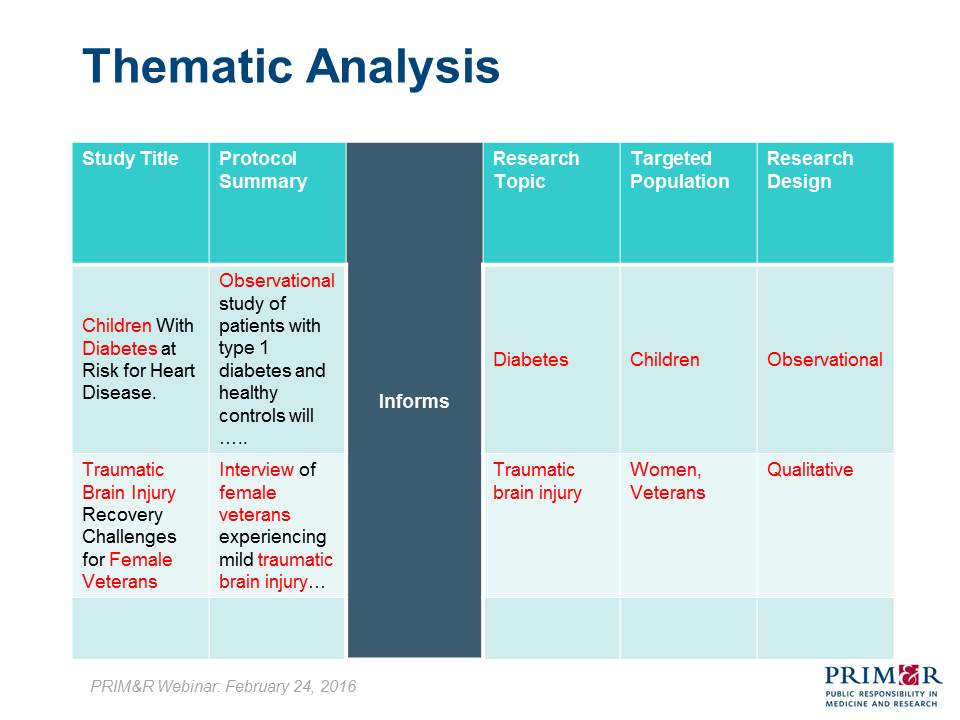Institutional review boards (IRBs) consistently struggle with identifying and retaining skilled, motivated members. How do IRB leaders navigate the challenges of maintaining a knowledgeable and committed IRB? Recently, PRIM&R hosted a webinar titled Identify, Recruit, Train, Retain: Building a Diverse, Qualified IRB, presented by Courtney Jarboe, MA, MS, CIP, education and outreach specialist at the University of Minnesota, and Ann Morrison, MA, PhD, assistant professor of special education at Metropolitan State University of Denver.
This webinar provided a roadmap for how to grow a strong IRB from the ground up. Ms. Jarboe explained how to identify gaps on your current board by collecting data on the volume and type of protocols your IRB reviews, as well as what populations are participating in and benefiting from the research. Ms. Jarboe shared an example of a way to organize your thematic analysis:
This table shows keywords associated with specific studies reviewed by the IRB. After collecting this data for six to twelve months, you will have a full picture of what topics and types of research are submitted to your IRB with frequency, as well as what populations are most affected by the research. For example, you may notice that your IRB reviewed a significant number of research protocols last year on children with diabetes. This may inform a decision to seek more pediatricians for your board. Ms. Jarboe explained that “themes and frequency together can be evidence to support your effort to increase membership, support the existing membership, and identify areas where the IRB could rely perhaps on consultants rather than standing IRB members for expertise.” You can use a similar chart to track information on current IRB members’ expertise and experience.
Ms. Jarboe addressed several challenges in recruiting members, including management of expectations about commitment and compensation, and emphasized the importance of developing a comprehensive and consistent strategy when communicating with IRB candidates. When potential members have been identified, they should be screened, interviewed, and evaluated systematically. Ms. Jarboe provided an example of an assessment tool used by her own institution, and provided a guide for interviewing candidates.
Educating your new IRB members is paramount to creating a board capable of high-quality protocol review. Dr. Morrison explained how to determine desired competencies of individual members and your board as a whole, and provided a framework for helping members attain those competencies while fostering a culture of accountability and continuing education.
Dr. Morrison encouraged attendees to observe the group dynamics and how individuals interact with one another during IRB meetings. What roles do certain individuals play within the larger group? Do some dominate meetings, while others are silent? What kinds of questions are members asking? Taking note of patterns will help IRB staff with individual members’ development, as well as identify gaps in the group’s knowledge as a whole. Dr. Morrison reminded us that “deep and sustained learning is driven by internal motivation.” Adults want to be involved in planning and evaluating their learning, they want skills and knowledge that can be applied immediately, and they want their existing skills and experience honored and incorporated into their learning. Dr. Morrison provided examples and strategies for how to incorporate adult learning principles into IRB member training.
Dr. Morrison concluded the webinar with strategies for reducing turnover, emphasizing again that internal and external motivation and incentives are key for long-term retention of board members.
Ms. Jarboe and Dr. Morrison showed that there are many reasons why an individual might want to join an IRB—professional development, the opportunity to participate in important and substantive discussions with others, and service to their community and institution, among others. It’s up to IRB staff and leaders to identify and tap in to these motivators.
The recording of this webinar is available for individuals to purchase in PRIM&R’s online store. If you’re interested in purchasing a recording for a group, please email webinars@primr.org.
PRIM&R would like to thank Ms. Jarboe and Dr. Morrison for sharing their expertise!

No comments! Be the first commenter?